Windows 10 is one of the most widely used operating systems, known for its versatility and functionality. However, not all users need the full version with all its features. Some prefer a lightweight version of Windows 10 that runs faster, consumes fewer resources, and improves overall performance.
This topic explores slimmed-down versions of Windows 10, their benefits, how to get them, and the best alternatives for low-end PCs.
What Is a Slimmed-Down Version of Windows 10?
A slimmed-down version of Windows 10 is a modified or lightweight edition designed to run efficiently on low-end hardware. These versions remove unnecessary features, reduce system resource usage, and improve speed.
There are two main types of lightweight Windows 10:
-
Official Lite Editions – Created by Microsoft, such as Windows 10 LTSC (Long-Term Servicing Channel).
-
Custom Stripped-Down Versions – Created by third-party developers who remove bloatware and optimize performance.
Why Use a Slimmed-Down Windows 10?
A lightweight Windows 10 offers several advantages, especially for older PCs, small storage devices, and low-power hardware.
1. Improved Performance
Faster Boot Time – A slimmed-down version starts up quickly.
Smooth Operation – Reduces lag and system slowdowns.
2. Reduced System Resource Usage
Less RAM Consumption – Uses fewer background processes.
Lower CPU Usage – Frees up processing power for essential tasks.
3. More Storage Space
Removes Unnecessary Features – No Cortana, Xbox apps, or telemetry.
Smaller OS Size – Takes up less disk space.
4. Better Privacy and Security
Disables Background Tracking – Prevents Windows from collecting excessive data.
Fewer Automatic Updates – Reduces forced updates that slow down the system.
Popular Slimmed-Down Versions of Windows 10
Several lightweight versions of Windows 10 are available, catering to different user needs.
1. Windows 10 LTSC (Long-Term Servicing Channel)
Windows 10 LTSC is an official Microsoft version designed for business and enterprise users who need a stable system without frequent updates.
✅ No Cortana, Microsoft Store, or Edge Browser
✅ Receives only security updates (no feature updates)
✅ Less bloatware and background processes
Best For: Businesses, power users, and those who need a stable and lightweight Windows 10.
2. Tiny10 – A Stripped-Down Windows 10 Version
Tiny10 is a custom lightweight version that removes unnecessary features to improve speed and efficiency.
✅ Requires less than 5GB of disk space
✅ Runs smoothly on PCs with 1GB RAM
✅ No bloatware, unnecessary services, or telemetry
Best For: Older laptops, low-end PCs, and users who want a bare-bones Windows 10 experience.
3. Windows 10 IoT Enterprise
Windows 10 IoT Enterprise is another lightweight edition, mainly designed for embedded systems and IoT devices.
✅ Minimal background processes
✅ Optimized for low-power hardware
✅ Long-term stability with security updates
Best For: Developers, embedded systems, and compact industrial devices.
How to Get a Slimmed-Down Windows 10?
1. Download Windows 10 LTSC from Microsoft
Windows 10 LTSC is officially available from Microsoft for enterprise customers. While not available for general users, some individuals obtain it through MSDN subscriptions or enterprise licenses.
2. Install Tiny10 (Unofficial Version)
Since Tiny10 is a third-party mod, it is not available from Microsoft. However, users can find community-supported versions online. Always download from a trusted source to avoid security risks.
3. Use Windows 10 Debloater Tools
If you want to create your own slimmed-down version of Windows 10, you can use debloater tools:
✔ Windows 10 Debloater – Removes unnecessary apps and services.
✔ NTLite – Customizes Windows 10 installation before installing it.
✔ DISM (Deployment Image Servicing and Management) – Removes Windows features manually.
Step-by-Step Guide to Install a Lightweight Windows 10
Step 1: Choose the Right Version
For stability → Use Windows 10 LTSC
For low-end PCs → Use Tiny10
For customization → Use a debloater tool
Step 2: Create a Bootable USB Drive
-
Download the ISO file of the lightweight Windows 10 version.
-
Use Rufus or Ventoy to create a bootable USB drive.
-
Insert the USB into your computer and restart it.
Step 3: Install Windows 10 Lite
-
Boot from the USB drive (Press F2, F12, or DEL key on startup).
-
Follow the installation steps like a normal Windows installation.
-
Skip unnecessary options to keep the system lightweight.
Step 4: Optimize Windows for Performance
✔ Disable Unnecessary Services – Turn off background processes.
✔ Turn Off Windows Updates – Prevent automatic updates that slow down the system.
✔ Use Lightweight Software – Replace heavy apps with open-source and portable alternatives.
Best Use Cases for a Slimmed-Down Windows 10
A lightweight version of Windows 10 is ideal for:
Old Computers and Laptops – Extends the lifespan of older devices.
Gaming PCs – Reduces background tasks for better performance.
Low-End Hardware – Runs on devices with minimal RAM and storage.
Privacy-Focused Users – Removes Microsoft tracking and telemetry.
Alternatives to a Slimmed-Down Windows 10
If you need a lightweight OS but don’t want Windows 10, consider:
1. Linux-Based Alternatives
Lubuntu – A lightweight Linux OS for old computers.
Zorin OS Lite – Windows-like interface with minimal system requirements.
MX Linux – Lightweight, stable, and customizable.
2. Chrome OS Flex
Google’s Chrome OS optimized for old PCs and cloud computing.
Fast, secure, and minimal system requirements.
3. Windows 11 Lite
Unofficial lightweight version of Windows 11.
Optimized for performance and low-end devices.
A slimmed-down version of Windows 10 is an excellent choice for users who need a fast, efficient, and lightweight operating system. Whether you choose Windows 10 LTSC, Tiny10, or a debloated version, these options help improve performance on older or low-end devices.
By removing unnecessary features and optimizing system resources, Windows 10 Lite versions provide a smoother user experience, better security, and extended hardware lifespan. If Windows 10 is still too heavy, Linux-based alternatives and Chrome OS Flex offer excellent lightweight solutions.
